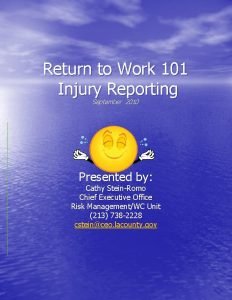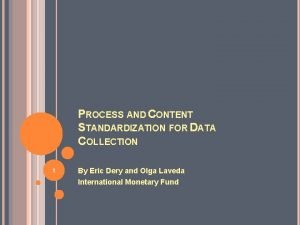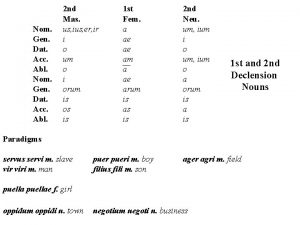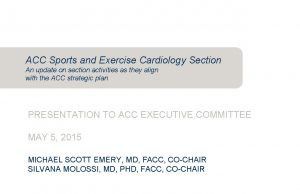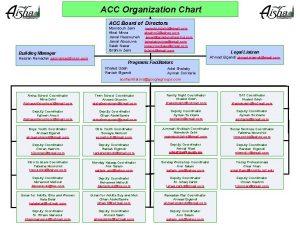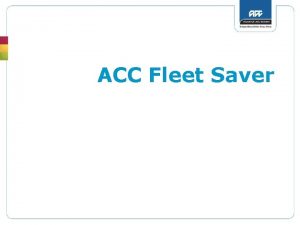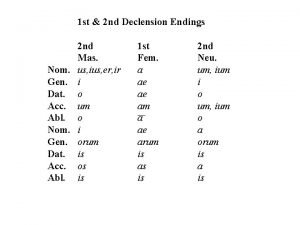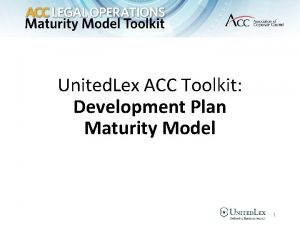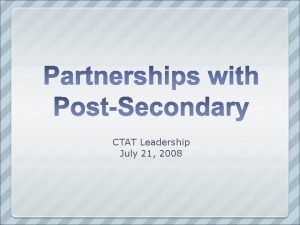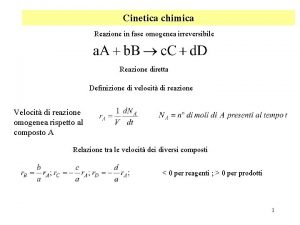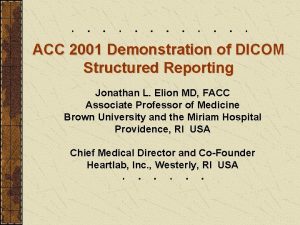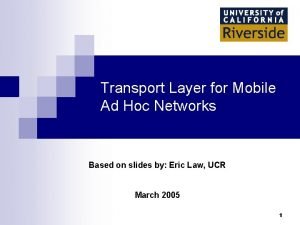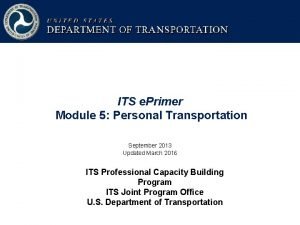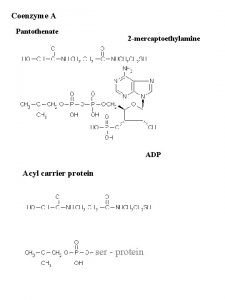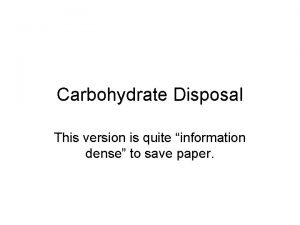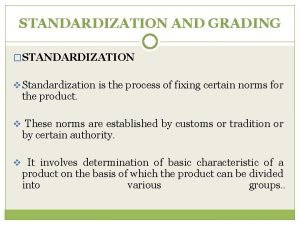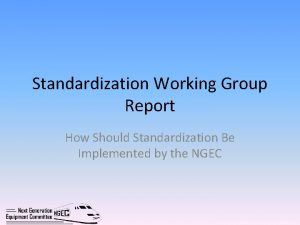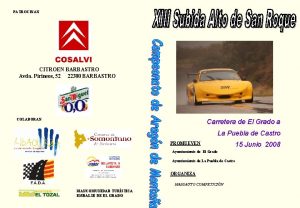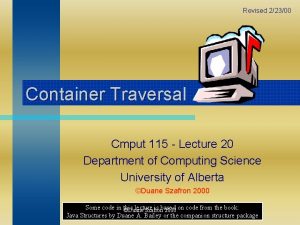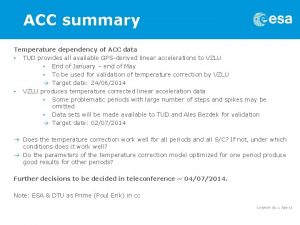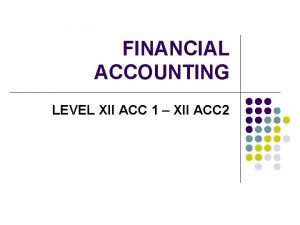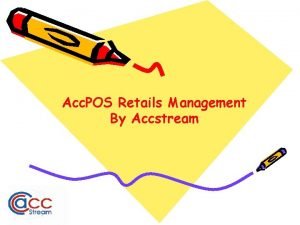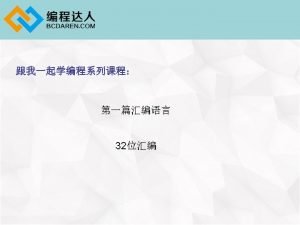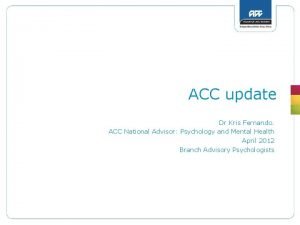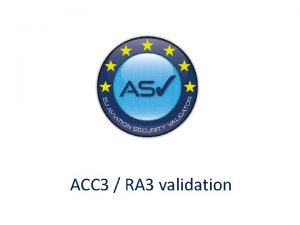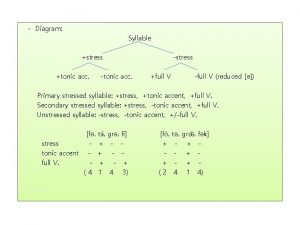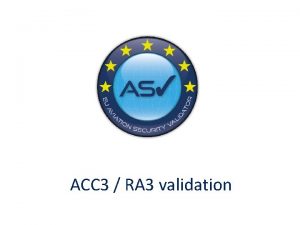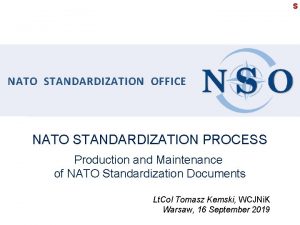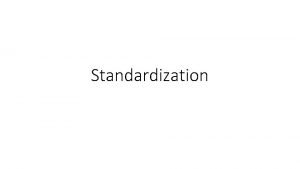Status Report ACC Process Standardization Work Group 22300








![Future Steps l Review other business models [CUBR, UIG, Other States] l Identify and Future Steps l Review other business models [CUBR, UIG, Other States] l Identify and](https://slidetodoc.com/presentation_image_h2/4b8b7e56000526660df6ae0dfece6009/image-9.jpg)




![Future Steps l Review other processes [CUBR, UIG, Other States] l Determine best model Future Steps l Review other processes [CUBR, UIG, Other States] l Determine best model](https://slidetodoc.com/presentation_image_h2/4b8b7e56000526660df6ae0dfece6009/image-14.jpg)









- Slides: 23

Status Report ACC Process Standardization Work Group 2/23/00

Policy Group

Charge/Objectives l Serve as a clearinghouse for policy issues l Develop a change control process to be used by PSWG l Address security and transport issues

Status l Adopted change control process l Reviewing issues list weekly l Developing data dictionary l Solicit market participant participation

Metering Group

Charge Develop recommendations on content of proposed business transactions and electronic transmission related to metering systems and meter reading, including transaction errors

Objectives l. Recommendations on best business practices in metering for the Arizona market l. Recommendations on data to be transmitted among market participants l. Short-term implementation recommendations l. Long-term implementation recommendations

Status l Focused on meter exchanges for bundled customers going to DA l Reviewed current UDC forms and practices l Identified common UDC processes l Developing Meter Data Element Comparison document l Developing UDC Business Practice Comparison document l Developing standardized data elements l Conducting ongoing review & resolution of metering issues
![Future Steps l Review other business models CUBR UIG Other States l Identify and Future Steps l Review other business models [CUBR, UIG, Other States] l Identify and](https://slidetodoc.com/presentation_image_h2/4b8b7e56000526660df6ae0dfece6009/image-9.jpg)
Future Steps l Review other business models [CUBR, UIG, Other States] l Identify and flow chart all business processes related to metering systems l Finalize common data elements for each process l Develop short-term solutions for data transfer l Identify implementation issues for smaller, regulated, and non-regulated entities

Billing Group

Work of Previous Group & Charge l Previous billing group accomplishments l Charge: . è Recommend best business practices in billing for the Arizona market è Short- and long-term implementation recommendations è Recommend timeline for implementation

Objectives l. Recommendations on best business practices in billing for the Arizona market l. Recommendations on data that should be transmitted among market participants l. Short-term implementation recommendations l. Long-term implementation recommendations

Status l Focusing Billing on ESP Consolidated l Reviewing UDC & ESP process flow for ESP Consolidated Billing l Developing comparison matrix of business process steps for ESP Consolidated Billing l Conducting ongoing review resolution of billing issues &
![Future Steps l Review other processes CUBR UIG Other States l Determine best model Future Steps l Review other processes [CUBR, UIG, Other States] l Determine best model](https://slidetodoc.com/presentation_image_h2/4b8b7e56000526660df6ae0dfece6009/image-14.jpg)
Future Steps l Review other processes [CUBR, UIG, Other States] l Determine best model for Arizona for ESP Consolidated Billing l Finalize common data elements l Create AZ 810 for ESP Consolidated Billing l Begin work on standardization of UDC Consolidated Billing

XML Overview

What is “XML” XML (e. Xtensible Markup Language) is a simplified subset of the Standard Generalized Markup Language (SGML, ISO 8879) which provides a file format for representing data, a schema for describing data structure, and a mechanism for extending and annotating HTML with semantic information

What Does XML Look Like ? <Header> <PONumber>ab 100</PONumber> <PODate>19980525</PODate> <Contact Name="Lew" Phone="800 -555 -1155"/> <Instruction Type="Bill. To"> <Addressee>Distributor Co</Addressee> <Address. Line>2345 Waukegan Rd</Address. Line> <Address. Line>E 100</Address. Line> <City>Bannockburn</City> <State>IL</State> <Zip>60015</Zip> </Instruction> <Instruction Type="Ship. To"> <Addressee>The Big Warehouse</Addressee> <Address. Line>4646 W. Main St</Address. Line> <City>Phoenixville</City> <State>PA</State> <Zip>19460 -4550</Zip> </Instruction> <Gen. Date Qual="Req. Delivery">19990614</Gen. Date> <Comment. Text>This is a PO</Comment. Text> <Comment. Text>Your business depends on how you process it</Comment. Text> </Header>

What Does EDI Look Like? ISA*00* *ZZ*FROMME *ZZ*2 U *000220*0908*U*00401*00001*0*T*~ GS*PO*FROMME*2 U*20000220*090819*1*X*004010 ST*850*1 BEG*00*BK*ab 100**19980525 REF*ZZ**This is a PO REF*ZZ**Your business depends on how you process it PER*AG*Lew*TE*800 -555 -1155 DTM*002*19990614 N 1*BT*Distributor Co N 3*2345 Waukegan Rd*E 100 N 4*Bannockburn*IL*60015 N 1*ST*The Big Warehouse N 3*4646 W. Main St N 4*Phoenixville*PA*19460 -4550 PO 1*1*500*EA*45. 26**IN*800 -ABT 1 MSG*Please paint this blue & trim in gold PO 1*1 A*1000*EA*22. 12**IN*900 -ABT 1 MSG*Please print this message CTT*2 SE*18*1 GE*1*1 IEA*1*00001

Why Consider XML ? • • • Self Describing Definitions (DTD) Application Reusable & Interoperability Define Your Own Schemas Flexibility Straightforwardly Usable Over The Internet • Easy To Write Programs To Process XML • Utilize Existing System And Processes

Why Consider EDI ? • • • Current Industry Wide Standards Formalized Process Flows Secure and Legal Interchanges Available Tools And Service Providers Proven Business Benefits Widespread Implementations in the Industry

What are Weaknesses of XML? • XML is a very new technology • XML needs to be integrated into the overall E-commerce business world • There is no benchmarking to prove the effectiveness of XML in the electric industry

What are Weaknesses of EDI? • • • Complex Document Structure (Relatively) Version Control Implementation Mechanics Data & Structure Only Maintain & Update Standards (Version Control) • Cost & Time to Implement • Dictated By The Major Business Partner

Why not consider XML-EDI?
 Project progress status
Project progress status Work status report from doctor
Work status report from doctor Kaiser code green
Kaiser code green Data standardization process
Data standardization process What is remedial approach in social work
What is remedial approach in social work A group vs a team
A group vs a team Smart work vs hard work group discussion
Smart work vs hard work group discussion Nyha disnea
Nyha disnea Us i o um o i orum is os is
Us i o um o i orum is os is Cima management accounting definition
Cima management accounting definition Acc sports cardiology
Acc sports cardiology Acc organizational chart
Acc organizational chart Accfleet
Accfleet Gen dat
Gen dat In-out+gen=acc
In-out+gen=acc Acc maturity model
Acc maturity model Catema acc
Catema acc In-out+gen=acc
In-out+gen=acc Acc shared memory
Acc shared memory Acc structured reporting
Acc structured reporting Control acc
Control acc Control acc
Control acc Acc etime
Acc etime Control acc
Control acc

